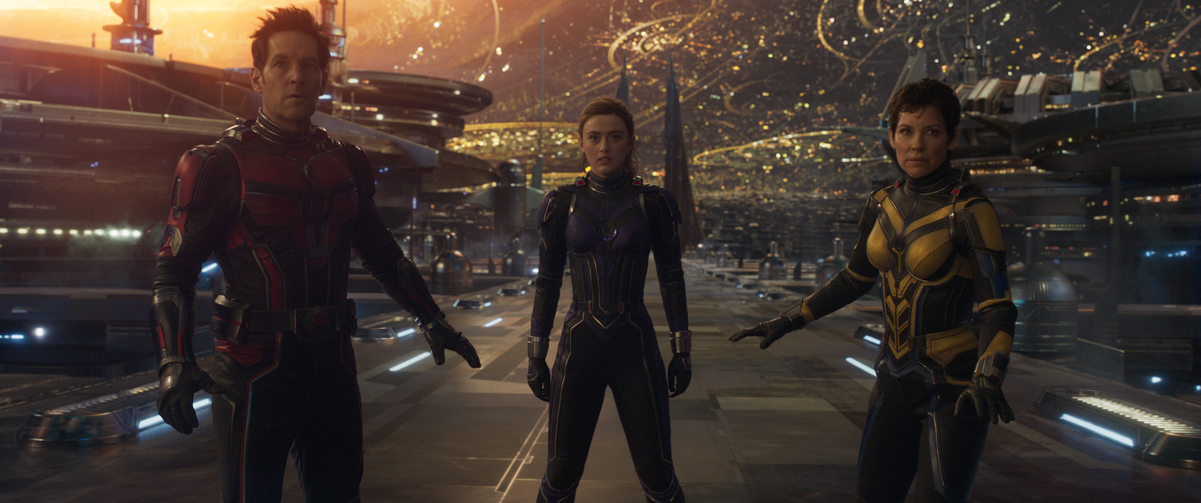For Paul Rudd, Evangeline Lilly, Michelle Pfeiffer, Michael Douglas, and Kathryn Newton, Going Small Means Big Stakes
DIRECTOR: PEYTON REED/2023
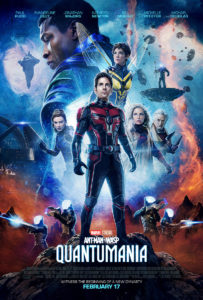
How many times can you save the world before it gets repetitive?
In the five years since Ant-Man starred in a standalone adventure and four years since he fought Thanos with the rest of the Avengers, Scott Lang (Paul Rudd) has learned to revel in the mundanity of universe-saving. He’s settled into a routine with his love Hope Van Dyne (Evangeline Lilly), who has taken over her father’s (Michael Douglas) company and turned it into a do-gooding powerhouse. He spends most of his days taking selfies with fans, though sometimes his now-grown-up daughter Cassie (Kathryn Newton, taking over from Emma Fuhrmann’s cameo in Avengers: Endgame, who took over from Abby Ryder Fortson in the first two Ant-Man flicks) interrupts by getting in trouble. Still, nothing has been the same since Janet Van Dyne (Michelle Pfeiffer) reappeared after 30 years in the Quantum Realm, and when a freak accident sends the family down to that electron-sized world, it becomes clear she’s been keeping secrets about her past.
TAYLOR BLAKE: The Ant-Man series has been one of my favorites of the Marvel Cinematic Universe for two reasons:
- The MCU is best when it leans into comedy
- The stakes have stayed small
Ant-Man and the Wasp: Quantumania reminds us again Paul Rudd is one of the funniest actors alive. His arid observations on the weirdness around him are exactly what a series built on talking to ants needs, and this sequel populated with tentacled, googly-eyed creatures (not to mention doppelgängers for Xena: Warrior Princess and George Lopez in Spy Kids 3) gives him more opportunities to cook than ever. Since series and comedy veterans Bobby Cannavale, Judy Greer, Michael Peña, and T.I. are sitting this round out and David Dastmalchian has shrunk his participation into a voice role, Rudd’s charisma and comedic timing are more important than ever.
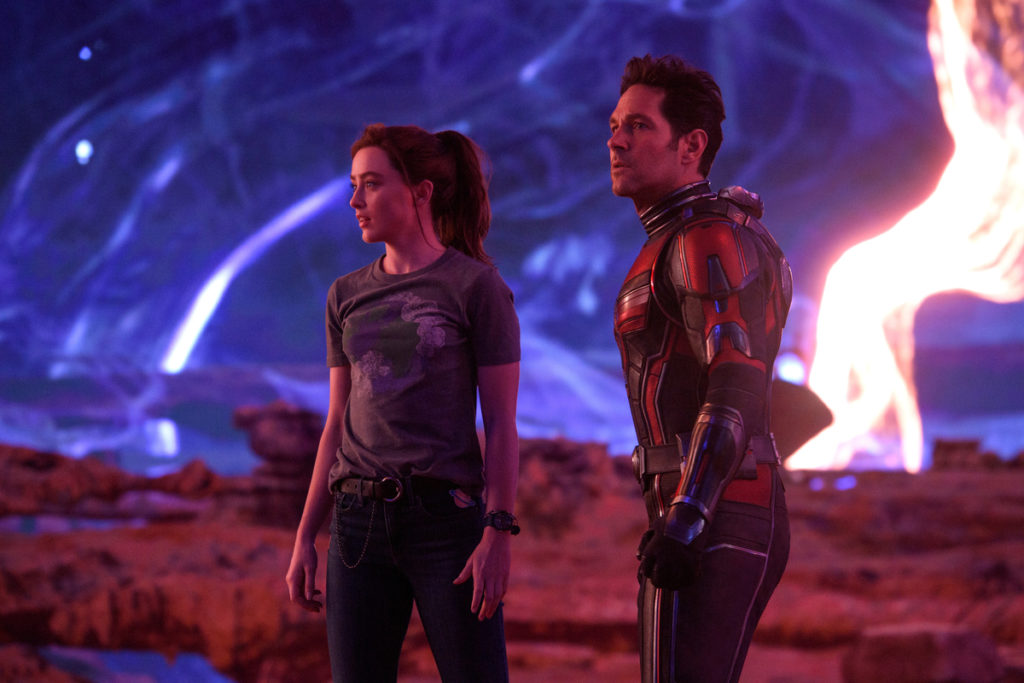
Also skipping out on Quantumania: the small stakes. In Ant-Man, Scott wanted visitation rights for Cassie, and in Ant-Man and the Wasp, he didn’t want to violate house arrest. How he achieved those goals involved high-tech super suits, but his biggest antagonists were corrupt businessmen in San Francisco. In his third adventure he’s battling Kang the Conquerer (Jonathan Majors), a humorless menace who first appeared in Loki, a Disney+ series centered on the Calvinistic implications of the multiverse. Majors broke out in the stellar The Last Black Man in San Francisco and continues to be a stellar presence here. Even better, Marvel appears to be setting him up as a Thanos-level Big Bad, which means he’s kicking off Phase 5 with the momentum Phase 4 lacked. But again, Ant-Man built its world on the premise of people talking to ants, so his gravitas and his oppression of the half-developed revolutionaries of the Realm are a tonal mismatch.
I suspect 80 or 90 percent of Quantumania was filmed in front of a screen on a sound stage, setting a different look and feel than the movies before it, too. The Quantum Realm will still look familiar to you, though—did the special effects team just copy and paste the Adobe After Effects files from the Star Warsserver over at Disney? The 15th time the vehicles, costumes, and Mos Eisley Cantina-adjacent sets reminded me of Cloud City, Coruscant, Death Star interiors, Jakku, Naboo, Starkiller Base, and Tatooine, I started worrying Quantumania was a backdoor pilot to connect the Marvel and Star Wars universes as Patton Oswalt predicted on Parks and Recreation. Thankfully, Disney has not jumped that shark as of yet.
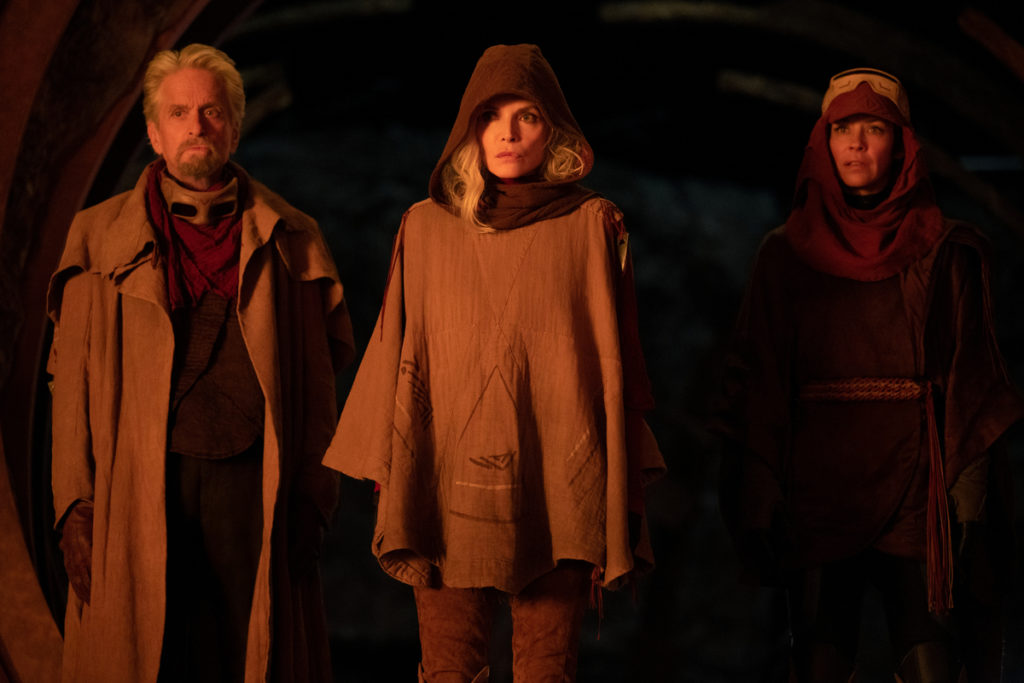
ERIK YATES: I thought similar things about the Star Wars cantina, as well as the vast difference in what is at stake in this third entry. Ant-Man and the Wasp: Quantumania positions itself to be the cornerstone of all that is coming in Phase 5 and beyond of the MCU, but loses some of its winsome charm in the process. The world that existed for Scott Lang in the first two Ant-Man films briefly bookends this film, and makes an appearance in one of the two after credit scenes, but this film is all about Janet Van Dyne’s backstory alluded to in previous entries when she was lost for 30 years in this quantum realm. This means that Michelle Pfeiffer gets a chance to truly shine in this entry and become the lynchpin to Kang’s multiverse.
For those only watching the MCU films, Ant-Man and the Wasp: Quantumania allows you to still understand what is taking place in terms of the multiverse, and concepts like variants and branches of timelines, etc. However, this is also a film where watching Loki, as you mentioned Taylor, would really enhance what you are seeing play out, as well as the future implications of the MCU alluded to in the final post-credit scene.
While still a worthwhile entry in the MCU, this film is perhaps too much of a tonal pivot from its previous entries. Sure there are some humorous moments, and Paul Rudd does succeed in holding all of this together with his ageless smile and inexhaustible charm, but things are just really heavy in this film…and complex. In addition to some of the complexities of the larger universe of the MCU (including Earth and the worlds beyond it), we also have the detailed parallel dimensions of the multiverse that we learned about in both Loki and in Doctor Strange and the Multiverse of Madness. Now, Ant-Man and the Wasp: Quantumania introduces us to the worlds and layers that exist in the subatomic world as well. Hopefully, Kevin Feige has a notebook to keep track of it all so that he can make sure the various directors of the next couple of phases of the MCU can consult to make sure it all continues to fit together. We really needed Michael Pena’s character Luis to break it all down for us, but as you mentioned Taylor, he and some of the other series regulars were sitting this one out. Perhaps the biggest surprise audiences will have though is to see which characters from previous entries do show up, including one massive secret I’ll keep to myself so it isn’t spoiled before audiences have a chance to experience it, though it too could have its own Patton Oswalt reference.
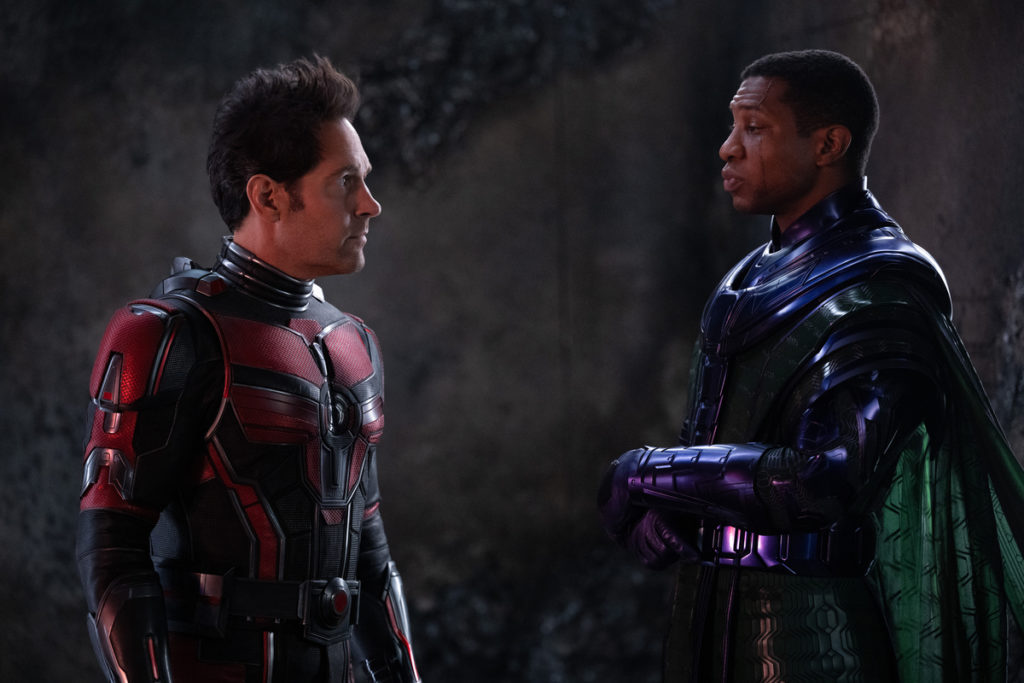
JIM TUDOR: As the resident (former) comics geek in the mix, my perspective on Quantumania is a little different than yours, Taylor and Erik. Though I checked out from actively following current Marvel comics around 2015, I enjoyed them quite avidly for decades. Unlike the MCU which sprang from said comics (Just look at the names of all those great creators buried in the end credits of every one of these things!)- the oft-overlooked source material- scores and scads of comic books, spread out over decades- is thoroughly tonally diverse. The movie series, on the other hand, has long ago settled into a recognizable template and vibe. This recognizability has been the MCU’s great strength but also it’s flashpoint for criticism. (Egads… do we need a “mansplaining old-guy geek alert” for all this?…) But I agree wholeheartedly with Taylor that it’s at is best when it leans into comedy. The Ant-Man series has been particularly on-point with this. For my money, that includes Quantumania– deadly serious Kang and all. (For the record, Janet’s Quantum Realm time, right down to the look and wardrobe of her time there, is straight out of an Avengers arc written by Brian Michael Bendis. Encountering Kang, however, was not).
I’d seen a blurb ahead of time that Quantumania is “the Star Wars of the MCU”. After blurting out, “Isn’t that Guardians of the Galaxy?”, my interest in the movie began to rise even higher. These days it takes a lot to get me jazzed about any movie, but I found myself looking forward to this one. It’s true that it leaves the refreshing low-stakes Ant-Man adventures behind, but MCU third chapters tend to always “go big”. (See: Captain America: Civil War; Spider-Man: No Way Home; Thor: Ragnarok; and perhaps the mother of all “part threes”, the double-whammy of Avengers: Infinity War and Avengers: Endgame). And yeah, it’s too bad how beloved supporting characters are marginalized or simply absent from these chapters. All that to say, I suppose I was ready for this to be the prolonged glorpy glowy globule-filled microverse mega-adventure that it very much is.
To me, Quantumania only resembles something that could be said to be “the Star Wars of the MCU” in its fight-filled third act. The churning magenta Quantum Realm landscape more closely resembles Disney’s Strange World, itself a love letter to pulp sci-fi of the early twentieth century. At times, yes, it does very much look like actors in front of a screen. There’s an unfortunate flatness about the all-CGI-all-the-time aesthetic that had me wondering if director Peyton Reed (who I’ve been enthusiastically following since he made the great Bring it On) was leaning into his experience helming episodes of The Mandalorian, and utilizing its newfangled StageCraft technology (aka “The Volume”). No acknowledgment of that in the end credits, though. It says that it was, however, shot at England’s Pinewood Studios, which hosted portions of every Star Wars feature film shoot since Disney acquired Lucasfilm. Coincidence? According to an Inverseinterview, Reed claims that Quantumania’s over-the-top settings stem from some cheesy/sexy precursors to Star Wars, namely 1968’s Barbarella and 1974’s Flesh Gordon. I can vouch for the Barbarella influence…
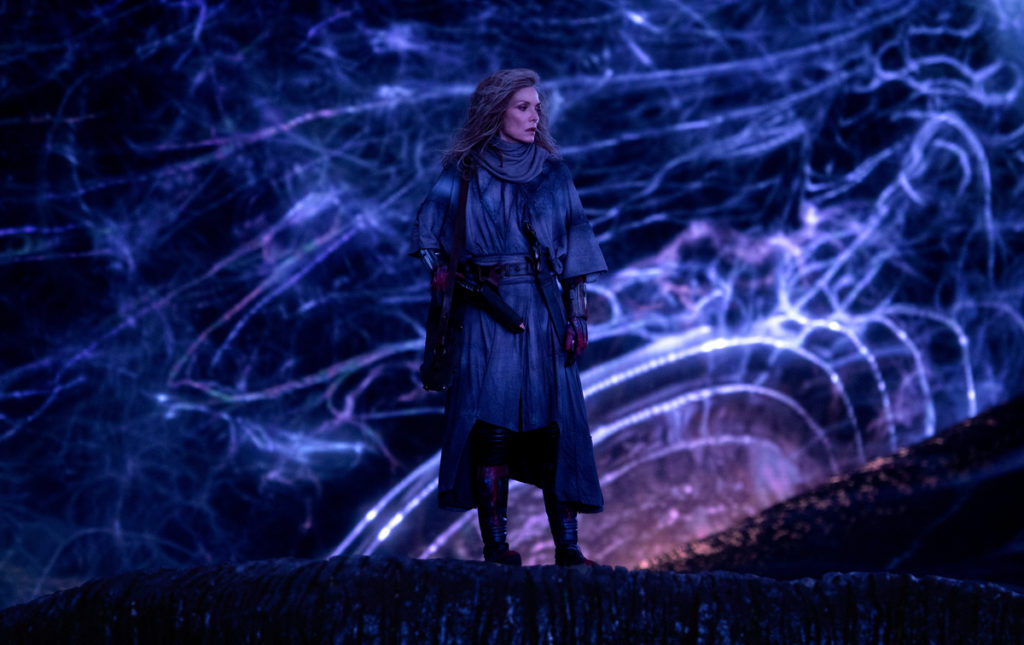
Ultimately, as someone who has come around to enjoying the MCU movies for what they are and not demanding that everything be a piece in some grand puzzle (it occurred to me when muddling my way through Disney+’s Moon Knight that with Marvel comics, I’d only stick with the characters I liked), I had a lot of fun with Quantumania. Rudd is truly funny in it, but can also sell the heft of the situation. I was pleasantly surprised by how much screen time Michelle Pfeiffer got, and how committed she is to this material that’s so far outside her typical wheelhouse. Majors as Kang is eminently engrossing, even as he’s operating in thoroughly different acting style than most anyone else in any MCU film. That’s a good thing. I was disappointed that the screenplay stooped to having Michael Douglas say the only good line of dialogue from Indiana Jones and the Kingdom of the Crystal Skull. (Ripoff or tribute? I’ll leave to others to specify, lest it be considered a spoiler). Newton, though, is the breakout story here. It’s her character that’s worthy of having her name in the film’s title, as opposed to Evangeline Lilly’s Wasp, who is merely along for the ride.
While I could’ve done without the shoehorned-in showpiece about complex-yet-vague infinite probabilities piling up, I do appreciate that throughout the chaos and craziness of it all, there’s a reasonably managed through-line about “looking out for the little guy”. Now that’s a Star Wars theme! The little guy might’ve finally gone real big, but it’s all in a day’s work in the MCU.


